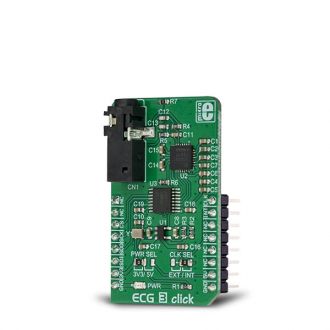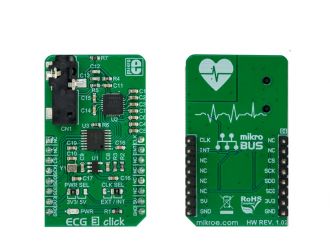
We strongly encourage users to use Package manager for sharing their code on Libstock website, because it boosts your efficiency and leaves the end user with no room for error. [more info]

Rating:
Author: MIKROE
Last Updated: 2018-12-12
Package Version: 1.0.0.0
mikroSDK Library: 1.0.0.0
Category: Biometrics
Downloaded: 5586 times
Not followed.
License: MIT license
ECG 3 click is a complete solution for the development of ECG applications, which utilizes a specialized clinical-grade biopotential analog front-end (AFE) IC. ECG 3 click is an ideal solution for the development of heart rate monitoring applications, fitness applications, for the ECG bio-authentication, and similar applications.
Do you want to subscribe in order to receive notifications regarding "ECG 3 click" changes.
Do you want to unsubscribe in order to stop receiving notifications regarding "ECG 3 click" changes.
Do you want to report abuse regarding "ECG 3 click".


Library Description
The library can perform a control of the ECG 3 Click board. Offers a choice to check registers, write to the registers, read ECG and RTOR Data. Also, the library performs calculations necessary to get Heart Rate in BPM value, and R - R Data in ms value. For more details check the documentation.
Key functions:
uint8_t ecg3_writeReg( uint8_t regAddr, uint32_t dataIn ) - The function writes data to the register.uint8_t ecg3_readReg( uint8_t regAddr, uint32_t *dataOut ) - The function reads data from the register.void ecg3_getECG( uint32_t *outECG ) - The function reads ECG data from the FIFO register.void ecg3_getRTOR( uint16_t *outHR, uint16_t *outRR ) - The function reads Heart Rate and R - R data and calculates Heart Rate data to BPM, and R - R data to ms.Examples description
The application is composed of the three sections :
void applicationTask()
{
ecg3_getECG( &ecgData );
plotECG();
}
Additional Functions:
Other mikroE Libraries used in the example:
ConversionsSPIUARTAdditional notes and information
Depending on the development board you are using, you may need USB UART click, USB UART 2 click or RS232 click to connect to your PC, for development systems with no UART to USB interface available on the board. The terminal available in all MikroElektronika compilers, or any other terminal application of your choice, can be used to read the message.